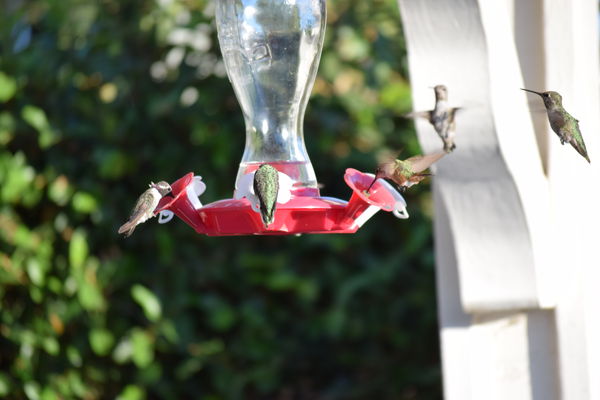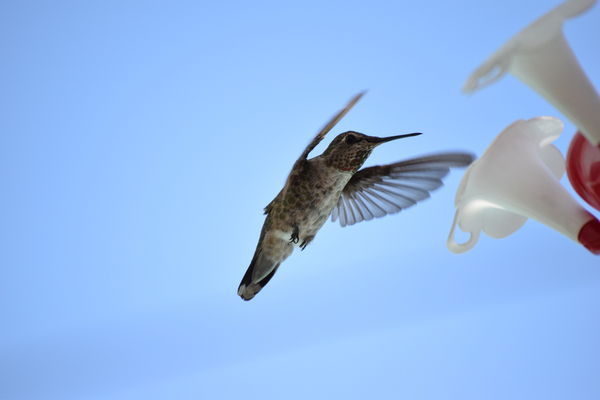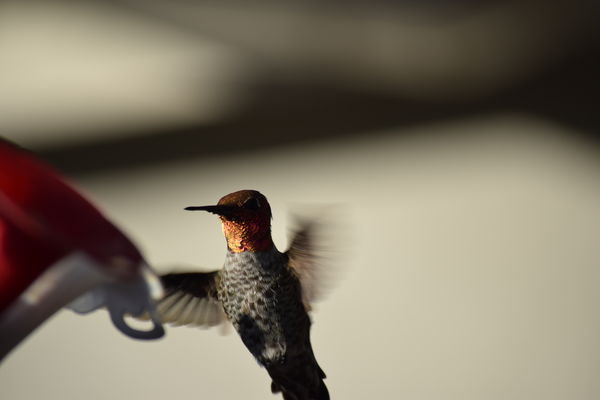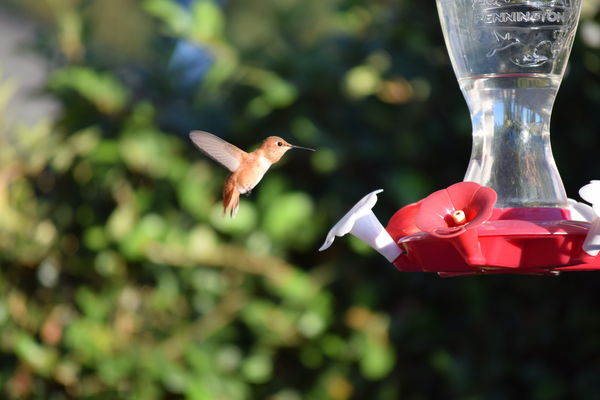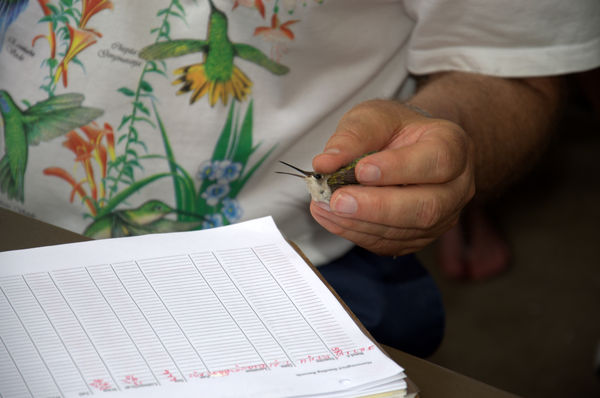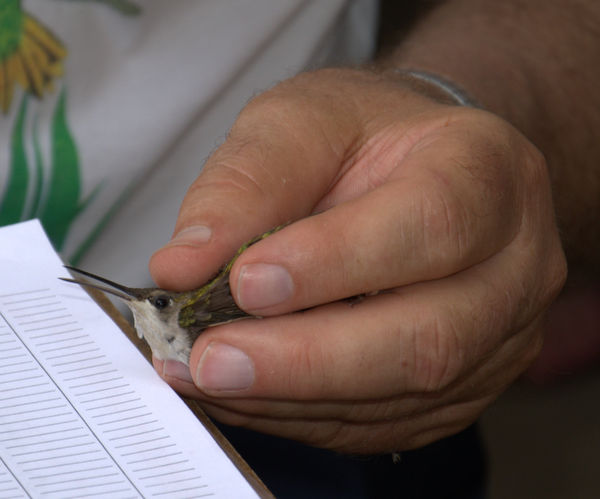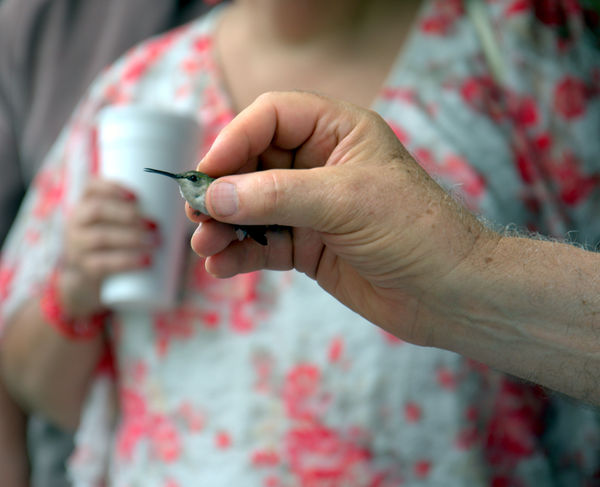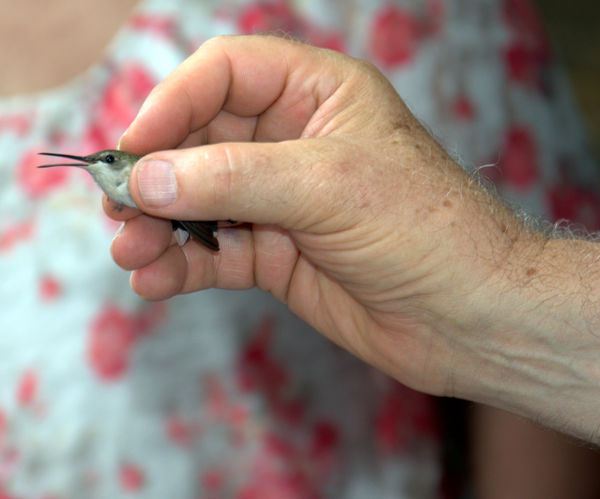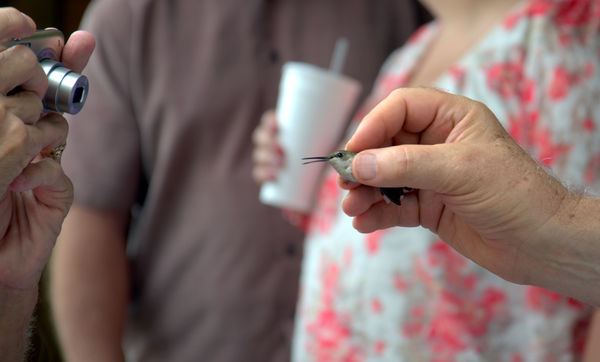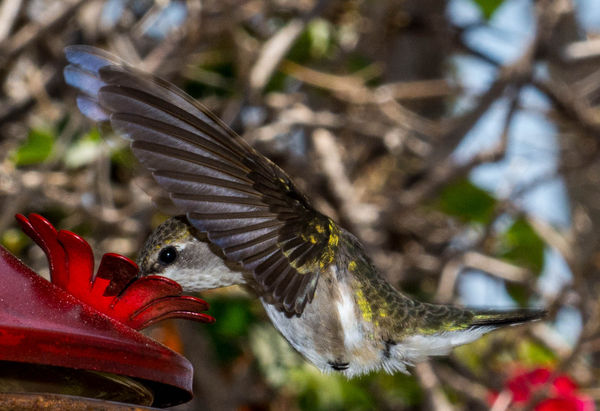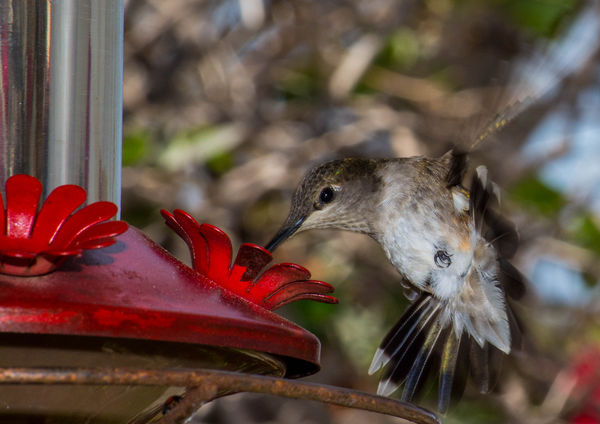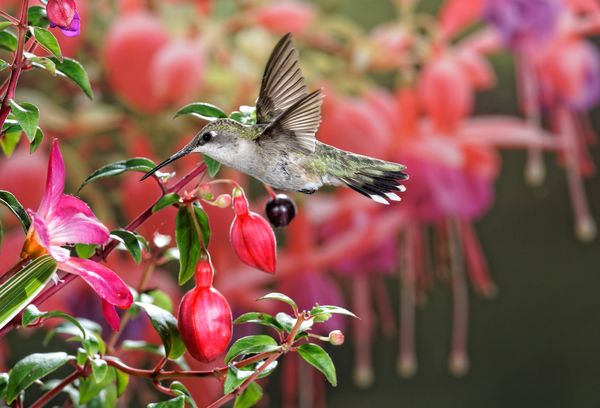Shootin Hummingbirds, Share your shots!
Jul 15, 2014 02:48:18 #
I love these little friends and their antics at times.
Juveniles will swoop in at about 24" and stare in your eyes.
Males will joust over a feeder, or camp out and try to drive off any wanting to partake of "His" flowers.
And on rare occasions even courting can be observed.
I feed a bunch out here. I started about 3 years ago, and quickly had to up my game to keep up. I started with one pancake feeder and some tiny one hole feeders. Soon I was filling the 6 smaller ones (2.5 ounces) 3 times a day!
Now we have 4 - 28 ounce, feeders up, and tonight I filled 3 of them. I only touch the bigger ones when they are empty. About every other day right now. The 2 pancake feeders as needed.
Sometimes one will try and "commandeer" a whole feeder, and drive off others. One day while watching the antics, one bird would swoop by drawing off the dominating male.
While leading him on a merry chase, the other two fed until he returned. Then off he'd go after a different one, and the decoy would feed.
At times a male will dominate a feeder, but let the females feed.
Sometimes there are 10-20 sitting on the wires crossing our backyard and they will swoop down and feed or battle. But it appears to be a social feeding time, usually mornings and evenings.
If you can get the sunlight right, often toward evening here, you can see a gnat cloud and watch them dart about snapping up the gnats. While nectar is their gas, gnats are their proteins.
Even before I ever hung up a feeder I use to like sitting out watching them dart through a gnat cloud like fish attacking a bait fish ball. Good riddance!
One morning while watching them and enjoying my coffee, I saw one picking something off the timbers of the patio cover. Curious, I slowly advanced and it was eating tiny newly hatched spiders from a web. That just thrilled the wife when I told her. She hates spiders.
I've fed other wild birds here and at our old house, but the humminbirds are here to stay. Tiniest droppings of any, and they hose away easily. The other wild birds, while welcome, are not fed or encouraged to stick around. Too messy.
We have a dove nesting in a hanging basket on the patio currently. She doesn't seem to mind the hummers, or me taking care of the feeders around her.
Today her mate returned and took care of the nest so she could feed. I wasn't here, but the wife got to watch out the window. Hopefully I can photograph that very soon.
The hardest to photograph are the Allen's Hummingbirds. They seem to be a bit wilder. Dressed in tan tuxedos with a dark band, or dark heads, the males and females alike are beautiful to watch. But a bit camera shy.
The Anna's are easy and very prolific. Some have even wintered over with us and will fatten up to where they fly like bomber, instead of a spitfire.
Concerned when people told me I had to take down my feeders to force them to migrate, I found invaluable information on the San Diego Zoo website. It is perfectly fine for them to winter over if they choose to. We had 6-8 that did.
Spring migration has become chaotic. Sometimes there are birds stacked waiting to feed. Hovering waiting for a feeder flower to open. Usually it only lasts for some days, to a week.
But often they will nest in the ivy on the fence, judging by the babies and juveniles coming to the feeders during the spring and summer. The babies are 1/2 the size of the adults.
So post some of your favorites, you're invited. :D
Juveniles will swoop in at about 24" and stare in your eyes.
Males will joust over a feeder, or camp out and try to drive off any wanting to partake of "His" flowers.
And on rare occasions even courting can be observed.
I feed a bunch out here. I started about 3 years ago, and quickly had to up my game to keep up. I started with one pancake feeder and some tiny one hole feeders. Soon I was filling the 6 smaller ones (2.5 ounces) 3 times a day!
Now we have 4 - 28 ounce, feeders up, and tonight I filled 3 of them. I only touch the bigger ones when they are empty. About every other day right now. The 2 pancake feeders as needed.
Sometimes one will try and "commandeer" a whole feeder, and drive off others. One day while watching the antics, one bird would swoop by drawing off the dominating male.
While leading him on a merry chase, the other two fed until he returned. Then off he'd go after a different one, and the decoy would feed.
At times a male will dominate a feeder, but let the females feed.
Sometimes there are 10-20 sitting on the wires crossing our backyard and they will swoop down and feed or battle. But it appears to be a social feeding time, usually mornings and evenings.
If you can get the sunlight right, often toward evening here, you can see a gnat cloud and watch them dart about snapping up the gnats. While nectar is their gas, gnats are their proteins.
Even before I ever hung up a feeder I use to like sitting out watching them dart through a gnat cloud like fish attacking a bait fish ball. Good riddance!
One morning while watching them and enjoying my coffee, I saw one picking something off the timbers of the patio cover. Curious, I slowly advanced and it was eating tiny newly hatched spiders from a web. That just thrilled the wife when I told her. She hates spiders.
I've fed other wild birds here and at our old house, but the humminbirds are here to stay. Tiniest droppings of any, and they hose away easily. The other wild birds, while welcome, are not fed or encouraged to stick around. Too messy.
We have a dove nesting in a hanging basket on the patio currently. She doesn't seem to mind the hummers, or me taking care of the feeders around her.
Today her mate returned and took care of the nest so she could feed. I wasn't here, but the wife got to watch out the window. Hopefully I can photograph that very soon.
The hardest to photograph are the Allen's Hummingbirds. They seem to be a bit wilder. Dressed in tan tuxedos with a dark band, or dark heads, the males and females alike are beautiful to watch. But a bit camera shy.
The Anna's are easy and very prolific. Some have even wintered over with us and will fatten up to where they fly like bomber, instead of a spitfire.
Concerned when people told me I had to take down my feeders to force them to migrate, I found invaluable information on the San Diego Zoo website. It is perfectly fine for them to winter over if they choose to. We had 6-8 that did.
Spring migration has become chaotic. Sometimes there are birds stacked waiting to feed. Hovering waiting for a feeder flower to open. Usually it only lasts for some days, to a week.
But often they will nest in the ivy on the fence, judging by the babies and juveniles coming to the feeders during the spring and summer. The babies are 1/2 the size of the adults.
So post some of your favorites, you're invited. :D
Jul 15, 2014 03:01:22 #
A few from Huntington Beach.
Female Allen's Hummingbird (Selasphorus sasin)
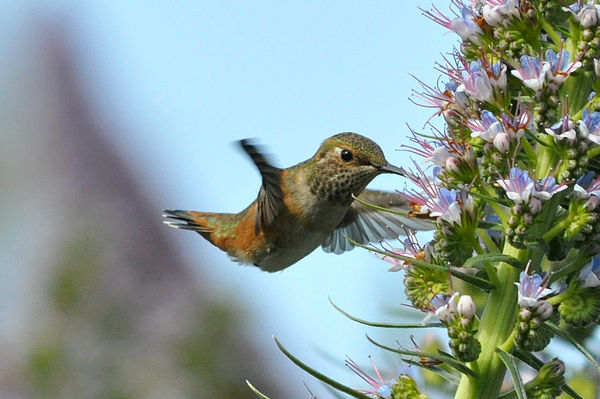
(Download)
Female Allen's Hummingbird (Selasphorus sasin)
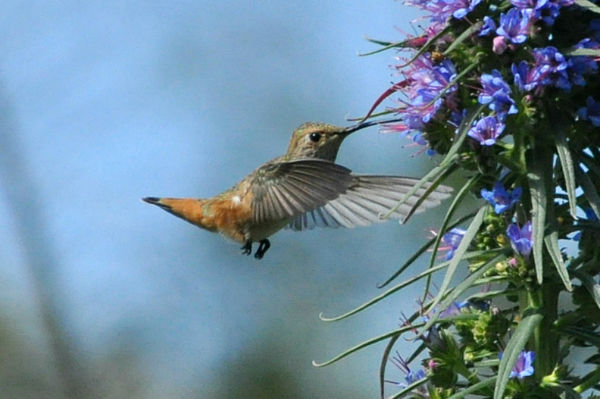
(Download)
Male Black-chinned Hummingbird (Archilochus alexandri)
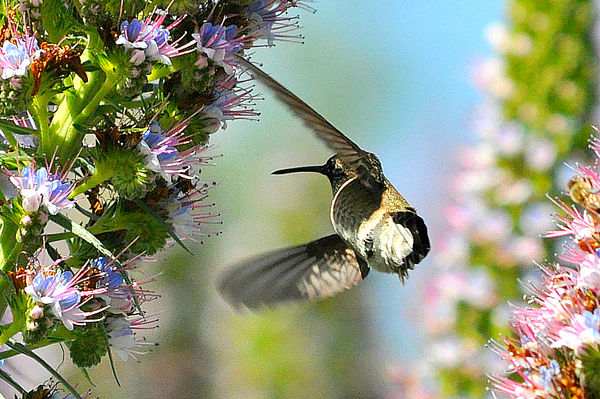
(Download)
Female Allen's Hummingbird (Selasphorus sasin)
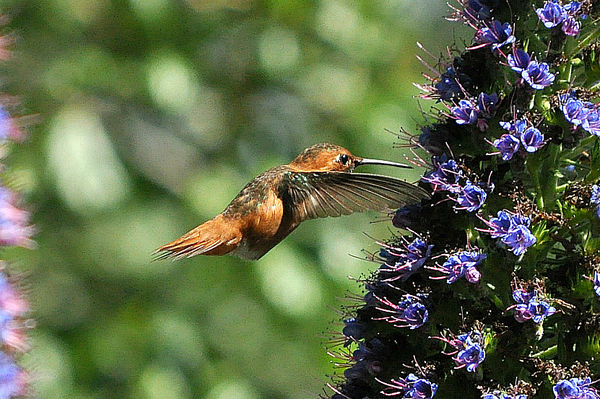
(Download)
Female Anna's Hummingbird (Calypte anna)
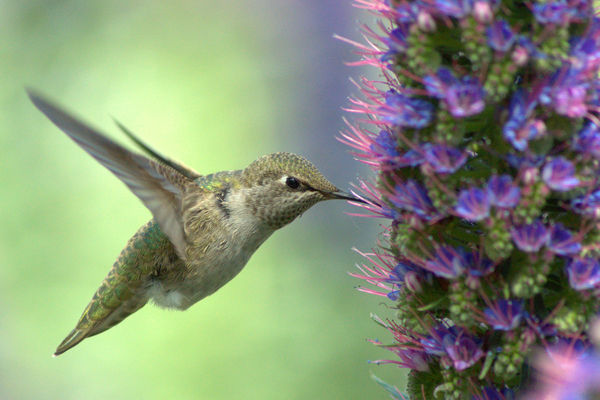
(Download)
Juvenile Male Anna's Hummingbird
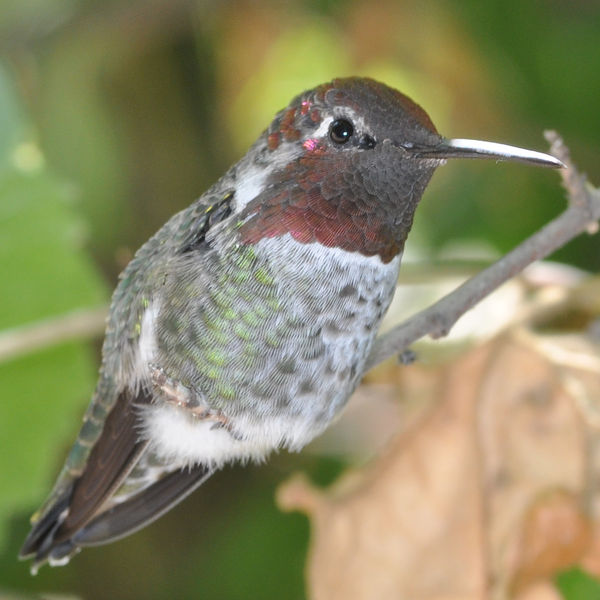
(Download)
Jul 15, 2014 03:04:31 #
Jul 15, 2014 03:08:09 #
Nikonian72 wrote:
A few from Huntington Beach.
Those are absolutely Gorgeous!
Something I hope to aspire to.
Thanks for sharing!
Jul 15, 2014 03:08:39 #
SonnyE wrote:
I love these little friends and their antics at ti... (show quote)
You are very lucky to have those little guys around to take pictures of.
I would encourage you to upgrade your camera and all other stuff, lenses, remote controllers, high speed flash, tripods, umbrellas and what have you. There has never been a more urgent need to get the latest and greatest. Don't be selfish and use budgeting as an excuse. Tell the wife that the Ugly hoggers need you to get the best. Its now or never.
Watch the Alphabet agencies closely as they will close you down like the rest of California. The EPA, DWL and the FDA say that if you enjoy it it is not regulated enough.
Do get all the new stuff but do not get bird watching permits or the entire Feral Government will stand in line to stop you.
BTW just to be on the safe side, the bird houses should be equipped with automatic fire sprinkling systems to stay on the right side of the fire department.
PS the pronoun guys is used to include the male and female gender of the species.
Jul 15, 2014 03:19:52 #
My hope right now is to get a really good telephoto lens to catch them at a better distance.
I have to get too close with what I've got.
Bird watching permits.... :hunf:
And nope, no bird houses. They are on their own to figure it out.
But they seem to come back year after year. :wink:
I have to get too close with what I've got.
Bird watching permits.... :hunf:
And nope, no bird houses. They are on their own to figure it out.
But they seem to come back year after year. :wink:
Jul 15, 2014 06:22:52 #
Wow how lucky can one person get, I am lucky to get a shot once in a great while, of the one that shows up once or twice a week and is terribly skittish
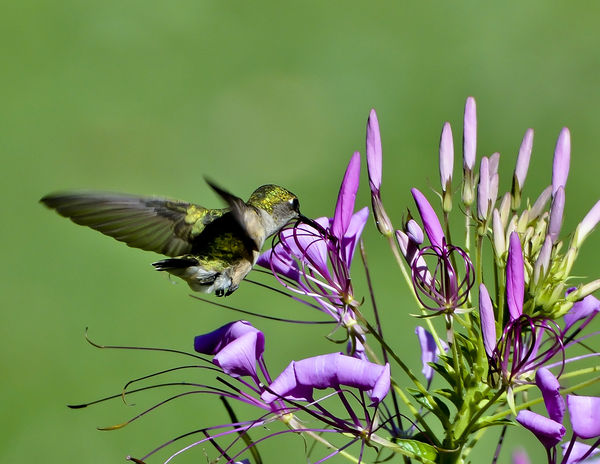
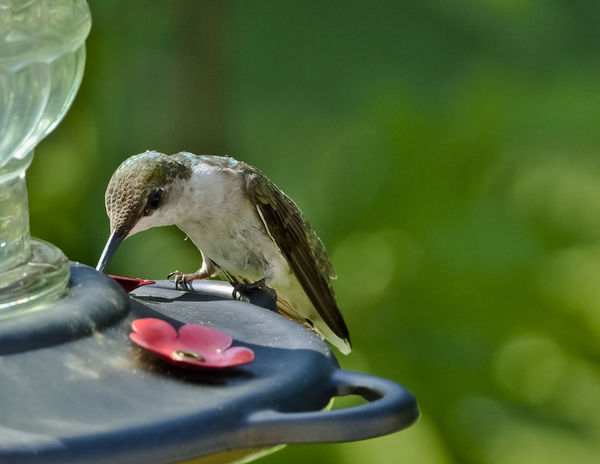
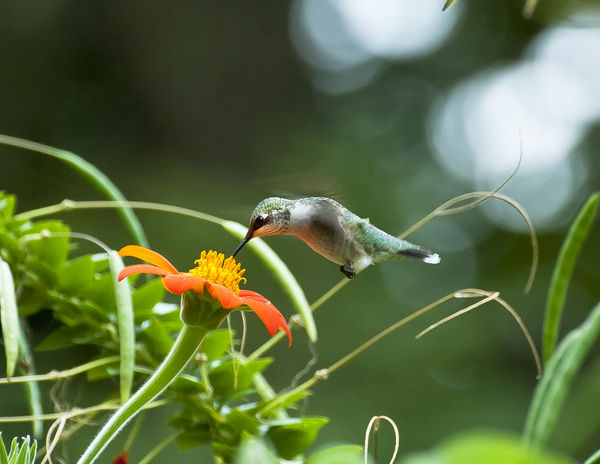
Jul 15, 2014 12:04:56 #
Photosmoke wrote:
Wow how lucky can one person get, I am lucky to get a shot once in a great while, of the one that shows up once or twice a week and is terribly skittish
Well for limited chances, you have some very nice pictures! :thumbup:
They can be very nervous and just shutter noise alone can send them darting away from me. Makes them a challenge.
But the juveniles will often fly in for a closer look. I usually wind up with blur... :roll:
Maybe they see their reflection in the lens? But even without the camera they will buzz in close sometimes.
I'm just starting out with my new camera. I've had the subjects, but just mediocre means to picture them before.
This morning I was experimenting with forced flash to see what that can do.
But often I have trouble catching their flash from the males on camera, only getting it in my minds eye. But I'm learning.
Looking at others compositions is a great help and inspiration for me to tune in my own shots.
Thanks for sharing your shots! :thumbup:
Jul 16, 2014 14:17:20 #
SonnyE wrote:
I love these little friends and their antics at ti... (show quote)
capture, record, band and release
Jul 16, 2014 14:48:06 #
JohnM wrote:
capture, record, band and release
OK. But why?
I'd rather let them fly free.
At .06 -.8 ounces, any band has to be a hindrance.
How about we band you? :shock: :twisted: :hunf:
Jul 16, 2014 22:03:59 #
SonnyE wrote:
OK. But why?
I'd rather let them fly free.
At .06 -.8 ounces, any band has to be a hindrance.
How about we band you? :shock: :twisted: :hunf:
I'd rather let them fly free.
At .06 -.8 ounces, any band has to be a hindrance.
How about we band you? :shock: :twisted: :hunf:
SonnyE, your OK.
Some tax payer rip-off program to study the little creatures. Seems like abuse to me. I would not like a 10 pound weight clamped around my leg so some alien can 'study' where I shit. :mrgreen: :twisted: :hunf:
Jul 16, 2014 22:10:40 #
SonnyE wrote:
I love these little friends and their antics at ti... (show quote)
Here are the ones I posted about a week ago. They are just a lot of fun to watch.
Jul 16, 2014 22:22:58 #
C.R.
Loc: United States of Confusion
the oldest hummingbird i'm currently aware of was captured in alaska a couple of years back, he had been banded when a fledgling in florida 12 years old when captured. there are channel island allens which do not migrate
Jul 16, 2014 22:27:17 #
Forrestloop wrote:
Here are the ones I posted about a week ago. They are just a lot of fun to watch.
Beautiful.
Jul 16, 2014 23:00:02 #
If you want to reply, then register here. Registration is free and your account is created instantly, so you can post right away.
